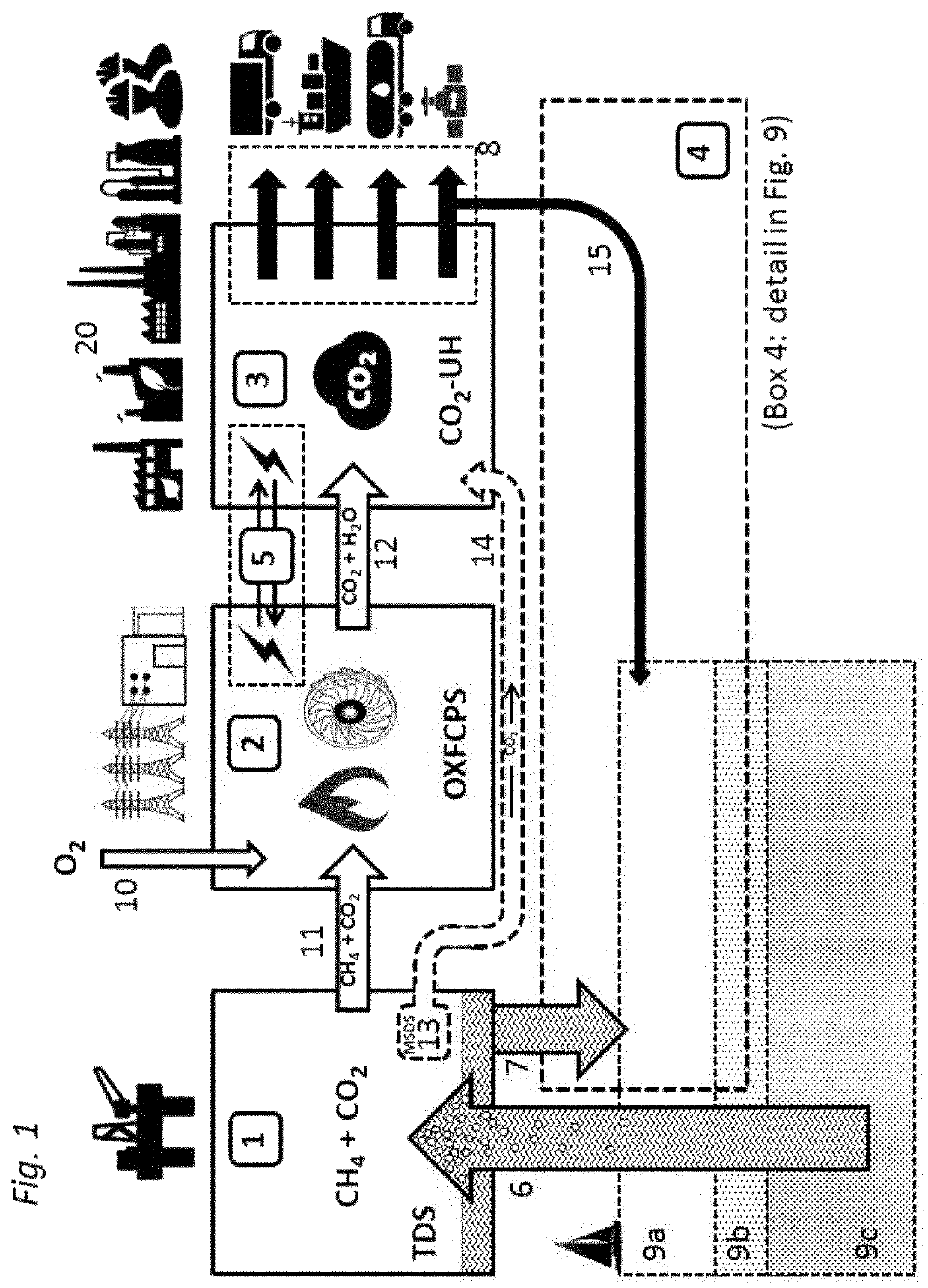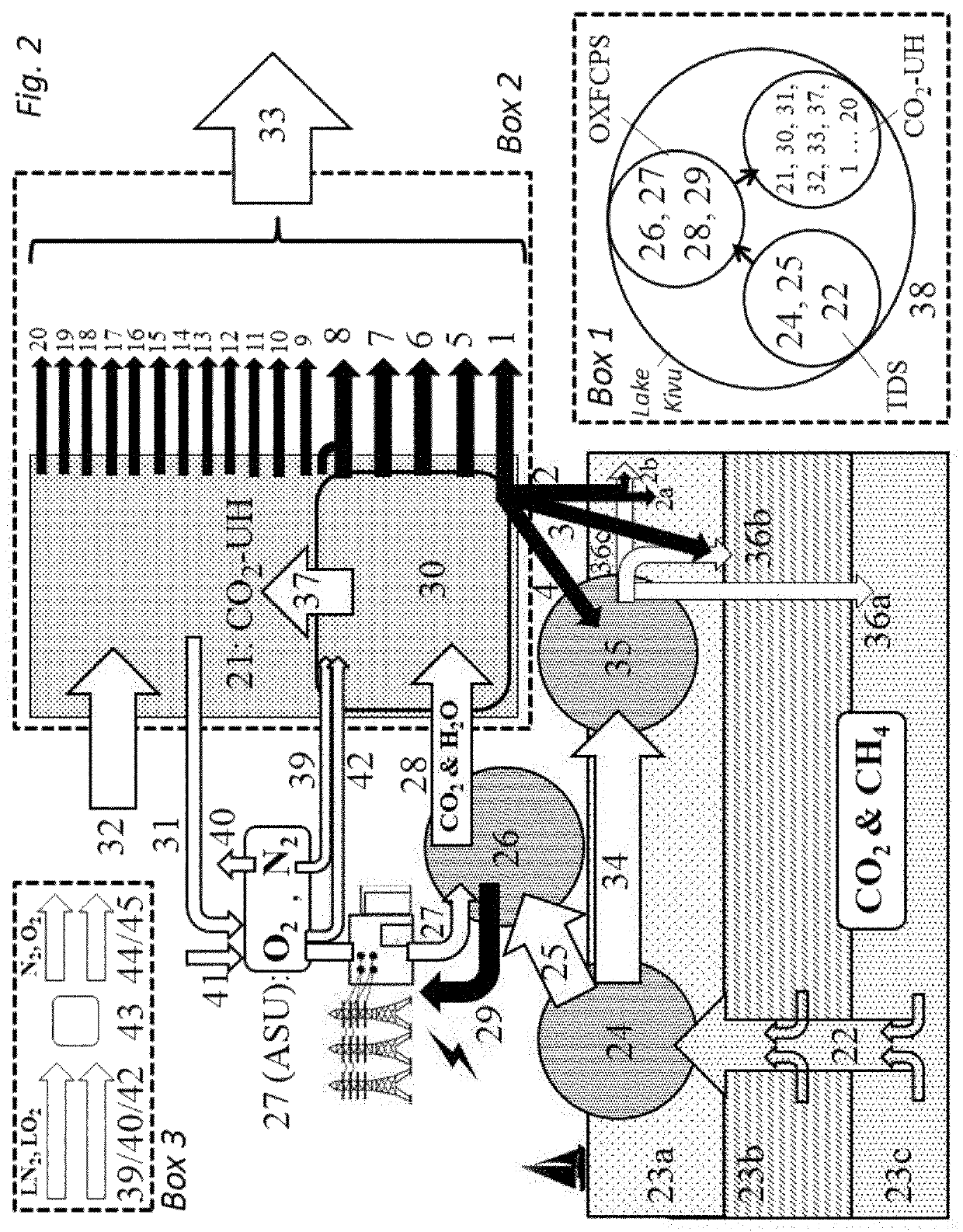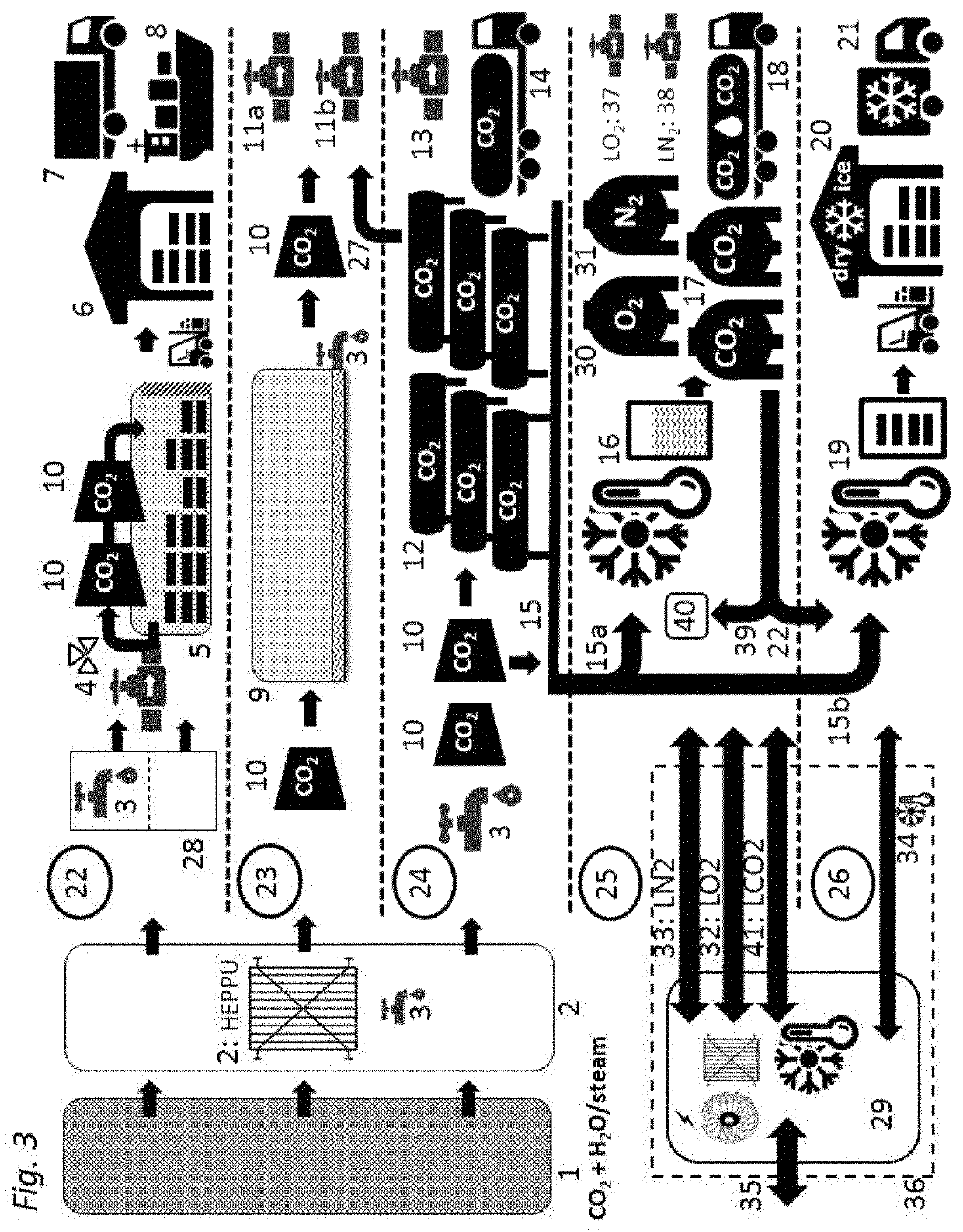A major challenge of the contemporary age is to halt the continuing increase in the CO2 concentration of the Earth's atmosphere.
It presents a mortal threat in the region as well as to the ecosystem of Lake Kivu.
In its maximal extent, such a catastrophe has the potential to asphyxiate more than two million people.
In general, CO2-dominated hyper-“acid” natural gas occurrences of the type present in Lake Kivu's deepwater are widely considered to be unattractive to develop.
Lake Kivu's CO2 has been considered to be a threat, an environmental nuisance, and an obstacle to be overcome for obtaining power efficiently from the dissolved methane that is present.
There is no separation of CO2 gas from water in production from these deep gas wells.
However, Rwanda is in a situation of high cost electricity (>US$0.20 / kWh) and high cost engine fuels (>US$1.2 / liter).
This situation is preventing realization of the country's economic goals.
Lake Kivu deepwater methane has been used for electric power production since the 1950s, but many problems exist and many substantial opportunities for additional resource utilization have not been realized.
However, artificial CO2 extraction does not increase the overall CO2 emission rate averaged over a timescale of hundreds of years.
The presence of so much geothermally-derived CO2 associated with biogas creates a major technical challenge to efficient extraction and use of Lake Kivu's biomethane.
The bioprocessing of return flow water additionally produces very large quantities of algal biomass and associated products.
None of these disclosures have addressed how optimally to utilize the full scale of the massive quantities of deepwater CO2 released by a “total degassing” process.
Environmental stewardship as well as industrialization opportunity makes CO2 utilization a vital unsolved problem and inventive challenge.
The increase of carbon dioxide (CO2) in the atmosphere from industrial activity is widely considered to have generated a substantial global risk from the possibility of major climatic system instabilities (IPCC, 2015).
Despite intense research and many impressive scientific-technological breakthroughs, only limited substantially scaled examples exist in industry.
Most of this CO2, however, is not recycled.
Strategies that encourage the persistence of mass poverty are unlikely to succeed.
Therefore a key challenge is to transform new industrialization, especially in developing countries, from standard high-CO2 modes to “greentech” modes.
This challenge therefore unavoidably must be focused predominantly on products in areas of very large-scale production in terms of mass.
A major challenge moving forward is to create economically viable examples of conglomerated CO2 utilization industrial networks.
This task has not been achieved.
The presence of an estimated approximately 500 million tonnes of associated CO2 trapped at depth in Lake Kivu in the MRZ and PRZ presents a major efficiency challenge.
Methane typically cannot be combusted efficiently for power production in the presence of large amounts of CO2.
Pre-combustion separation of CO2 by various differential extraction and gas-cleaning technologies requires substantial power production efficiency loss as well as large capital investment in equipment.
The presence of so much CO2 trapped at depth in Lake Kivu presents a serious threat of mass asphyxiation of the ˜2M people living in close proximity to the lake within its basin (Baxter et al., 1989; Costa and Chiodini, 2015).
Long distance transport of CO2 can be expensive, adding a cost in the range of US$15 to $35 per tonne for compression and transport on the scale of about 500 km (Kuang et al., 2015.
Operational problems in producing and transporting such oils include precipitative clogging by wax and asphaltene precipitation both of the reservoir during extraction, as well as pipeline clogging above ground.
Oils of this type are expensive to extract and trade at a discount.
Hard-to-produce heavy oils are abundant worldwide.
Escalating use of wild-caught forage fish for aquaculture / mariculture feeds is grossly harmful to the sustainability of world forage fish populations and their associated fisheries (Sorensen et al., 2011; Kleivdal et al., 2013; BlueBio, 2013; Reitan, 2013.
However, CO2BIO perhaps is unlikely to create large-scale algal production operations adjacent to Mongstad.
However, none thus far have been specifically designed.
Wind and solar inputs, as well as small- and micro-hydropower inputs, often are highly irregular and unpredictable in time and scale.
However, another technology exists approaching large-scale commercial applicability.
None of these systems, however, offer multi-product CCU platforming beyond horticultural products.
However, CCU has not been developed at Agriport A7 beyond the core industrial symbiosis connecting CHP systems with greenhouses.
It therefore inverts the usual problem that high CO2 inflow with methane fuel causes a decrease of power generation efficiency.
However, this process does not stop early infestations before CO2 build-up.
However, no detailed studies of fruit yields are published.
However, low-cost CO2 typically is unavailable in developing countries.
This is wasteful of both energy and CO2 unless recycled.
CO2, however, is not a fuel that allows trivially practical access to the energy it carries.
CO2 energy release technologies based on the weathering of olivine and related minerals and rocks have not yet been commercialized.
However reaction kinetics often are very slow.
Therefore accelerating mineral dissolution with low-energy, low-cost and low-waste methods is an important technology development challenge.
CO2 utilization via carbonation-hydration in producing MgO board in a CO2-rich atmosphere is possible, but not yet commercialized.
However, it has only begun to be demonstrated in research labs and in a few pioneering industrial applications.
However, CO2-utilizing Mg-based cements involving hydrated Mg-carbonates require careful formulation and preparation as well as use limitations to low temperatures (<˜50 degrees C., Morgan et al., 2015).
However, it has a poor thermal stability range limiting for practical purposes to less than ˜50 degrees centigrade (Walling and Provis, 2015; Unluer and Al-Tabbaa, 2015b; Highfield et al., 2013).
The method, however, has never taken off industrially.
The obvious reason is that facilities for high-pressure carbonation treatment of molded building materials with supercritical CO2 are rare and expensive, and also because CO2 typically obtained for such uses is costly.
However, such reasons are not fundamental impediments that apply to all circumstances.
Propylene has been demonstrated by Dow to be bio-manufacturable by fermentation utilizing commodity sugar input, though not in an economically competitive manner (Rodriguez et al., 2014; Nextant, 2009).
A high cost of production has been a substantial impediment against rapid uptake involving a very wide variety of high tech uses involving strength as well as electronic properties.
The world market for carbon nanofibers, however, is small at present: perhaps less than 10,000 tonnes per year (Sherman, 2007; Johnson, 2014; Davenport, 2015; McKenna, 2015).
However, these authors noted this was based substantially on a low process selectivity, CO2-to-formate of only 40%, with expectations of future enhancement.
It is too early to know if such biological power-to-gas methods utilizing CO2 will have sufficient efficiency to have commercial potential.
However, it fills more mass into standard LPG bottles.
However, catalysis for efficient production via this reaction has not yet been developed (Zhang et al., 2003: Khirsariya an Mewada, 2013).
However, the high pressure and temperature process conditions are non-trivial for industrialization.
However, both PV and CSP technologies are following well-demonstrated innovation trends of increasing efficiencies with decreasing costs in their industrial applications.
Despite these many, scientific and engineering insights, designs, teachings, products, methods, systems, business activities, safety threats, development-industrialization needs, and ecologically significant opportunities having to do with Lake Kivu, its deepwater resources, and CO2 utilization, no efforts have been made to design inventive methods and / or systems to co-extract and co-utilize the lake's abundant CO2 resource in the context of extracting and utilizing its methane resource.
 Login to View More
Login to View More 


